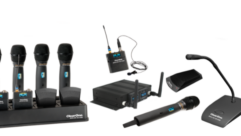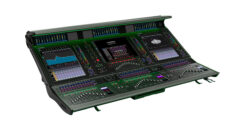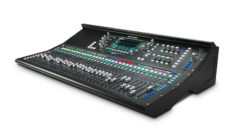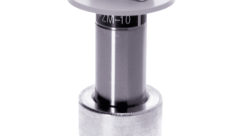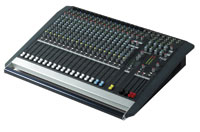

Technology Showcase: Powered Mixers
Sep 2, 2009 12:00 PM,
By Bennett Liles
Flexible all-in-one mixers are ready to tour.
Allen & Heath PA20-CP
While the concept of mixers with built-in power amps is certainly not new, there have been some amazing strides made in this line of products because of the advances in power amp design and electronics integration. The models we will explore here are designed for live sound and primarily for mobile applications rather than for permanent installation, such as in paging systems. In venues with space restrictions, though, the solutions represented here can certainly be used in a permanent setup. Most of these units can be connected directly to loudspeaker systems or connected using only the mixer section with line-level outputs run to external power amplifiers. Their primary advantage is in taking live sound on the road with the mixer and power amps contained in one compact enclosure.
The PA20-CP is a powered version of the Allen & Heath PA Series mixer using the company’s Constant Power system to deliver 500W RMS power on each stereo side into either a 4Ω- or 8Ω-load. The output signal is selectable to carry left and right stereo, left plus right mono, foldback 1, or foldback 2. Maximum flexibility is provided through inclusion of master trim control, level meters, slave outputs, 4-band semiparametric equalizers, and patch points for connection of external processing gear, if needed. The features of the PA20-CP allow the board to be used as a standalone sound system connected directly to main house loudspeakers or to be used in conjunction with an existing sound system where the mixer’s power outputs can be used for equalized stage monitoring or powered feeds to other locations. The meters provide a peak threshold indication 5dB before clipping, and there is a 4-pin lamp connector on the rear of the console.

Alto APM200
With 16 microphone input channels and two line-level stereo inputs, the APM200 from Alto incorporates a 24-bit digital effects section with 16 factory presets and 16 variations for every preset for a total of 256 custom digital effects. Each mic input channel has 3-band EQ controls, and the stereo input channels with balanced TRS input jacks feature 4-band EQ. The mixer also features a 9-band graphic EQ, a peak LED indicator on each input channel, and a continuously variable input pad knob along with a 12-segment bar graph meter on the main outputs. The mic channels also have a 75Hz, 18dB-per-octave low-cut control. To provide maximum space for operator controls, the input connectors are located on the back of the console, where each channel includes a 1/4in. line input jack, an XLR mic input connector, and a TRS insert patch point. Slide switches control phantom power to the mic inputs in groups of four.
1
Technology Showcase: Powered Mixers
Sep 2, 2009 12:00 PM,
By Bennett Liles
Flexible all-in-one mixers are ready to tour.

Behringer Europower PMP5000
The Behringer Europower PMP5000 delivers 1200W in bridged mode with 20 input channels, a Dual Multi-FX processor, and FBQ feedback detection system. In stereo mode, the amplifiers provide 600W per channel to the loudspeaker outputs. The mixer has 12 mono mic/line inputs and four stereo input channels with separate tape returns. The two effects processors offer 100 presets with combinations of reverb, chorus, flanger, delay, and pitch shifter. Each mono input includes 3-band EQ, a switchable low-cut filter, and clip LED indicators. The 7-band graphic EQ can be switched to control either the main outputs or the monitor outs, and the amplifier output can be switched between stereo, dual mono, and bridged mono modes. There is also a standby switch that mutes all mic inputs while allowing the adjustable level CD/tape input to connect to the amplifier outputs. For external power amplifiers, the unit has multifunctional stereo preamp outputs.
Related Links

Audiomixers: in houses of worship
An audio mixer must perform many different tasks in houses of worship, some conventional and some not. To understand the needs of the modern worship system,…

Audio Review: Soundcraft FX16ii
It seems like every time you turn around, there’s another small-format digital mixer. I don’t mean to sound disdainful. I’m a digital mixer owner myself,…

Technology Showcase: Live Digital Mixers
Is there a digital mixer in the house? Ever more frequently, the answer is, Digital boards have been around long enough to wear into the market, and they…
For those who prefer the road case form factor, the RX800 from Carvin has four internal amplifiers. Two of these deliver 300W RMS per channel directly into main loudspeakers while the other two provide the same power level into two monitors at 4Ω using both Twist-Lok and 1/4in. connectors. Each amplifier has peak and protect LED indicators. Two independent 24-bit stereo DSP effects sections allow the user to separately program effects for each channel, and the effects are assignable to the stage monitors. Any of the 256 effects can be used with factors such as reverb, chorus, flanging, and echo with parameters including depth, decay, damping, speed, regeneration, and time. Each channel offers 3-band active EQ with low-frequency control beginning at 20Hz and going up to 80Hz and shelving controls at each end of the spectrum. For output EQ, there are four separate 7-band graphic equalizers. Distortion-free opto-isolators provide limiting and protect the amplifiers against input overload.

Dynacord PowerMate 2200
The Dynacord PowerMate 2200 features dustproof Alps faders, phantom power switchable to the inputs in groups of six, and aux 3 and aux 4 buses that are individually switchable between pre- and postfader. Each output channel has a Class H power amplifier that puts 700W into a 4Ω load with protection including short circuit, overheating, DC voltage, and HF/back EMF along with dynamic limiters. Dual digital effects processors provide 99 foot-switchable presets, and the unit may be used with the internal power amps or as a standalone mixer with external power amps. Input gain controls have a range of 60dB, and each channel has 3-band EQ with semiparametric mids, PFL, and mute buttons. There are four stereo input channels, and the outputs have 7-band graphic EQ and feedback filters. Protection includes a momentary delay in the loudspeaker output as the board is powered up to enable the amplifiers to stabilize and avoid loud transients in the loudspeaker system.
2
Technology Showcase: Powered Mixers
Sep 2, 2009 12:00 PM,
By Bennett Liles
Flexible all-in-one mixers are ready to tour.
For those who prefer a powered mixer in a carry-around, rack-style enclosure, the Kustom KPM 8420 offers a basic flexibility feature in its dual 200W assignable amplifiers. With this, 200W can be sent to the main loudspeakers and the second 200W can go to the monitors, or the unit’s entire 400W of power can be sent to either. Eight input channels with combination XLR-1/4in. connectors allow both mic and line-level sources to be used along with instrument preamps on two of the channels, eliminating the need for external direct boxes. Each channel also features 3-band EQ, separate main and monitor sends, and separate effects 1 and effects 2 sends. There is also a pad switch on each input channel providing 12dB attenuation. Channels 7 and 8 have a button for switching the 1/4in. input connector between line and instrument preamp functions. Dual effects processors, each of which can be sent to main and monitor outs, provide a choice between preset effects. Two 7-band graphic EQ sections allow output sound shaping and offer a feedback notch filter.

Mackie PPM1012
The Mackie PPM1012 has twin internal power amps generating 800W peak power each into 4Ω with three selectable amplifier modes: stereo main, mono main and monitor 1, and monitor 1 and 2. The unit provides 12 input channels with eight mono and two stereo. The mono channels have both mic and line inputs along with TRS insert patch points. The PPM1012 also has two monitor outs, two effects sends, left and right main outputs, and a mono output with the same XLR and 1/4in. connectors as the left and right main outs. The rear panel has stereo tape in and out on RCA connectors, a headphone output with level control, a footswitch connector for muting/unmuting effects sends, and a 12V lamp connection on a BNC. Input channels 7 and 8 can be switched to allow direct instrument connection with internal preamps. The mixer’s phantom power is globally controlled by one switch.

Nady Systems PMX-1600
The PMX-1600 from Nady Systems puts 225W RMS per channel into a 4Ω load and the amp circuits include fan cooling, short-circuit protection, current limiting, loudspeaker DC protection, clip indicators, and a loudspeaker protection on/off delay to prevent loud thumps. The board offers left and right main-mix-out master faders with two group masters that are routable to the main mix output. All faders are 60mm, and there is a built-in 32-bit DSP that emulates plate, gate, room, hall, stadium reverbs, and delays. Each channel has an XLR input, a 1/4in. line input, and an insert patch connection along with a level trim control, 3-band EQ with mid-frequency adjustment, aux 1 and aux 2 sends, a stereo pan control, and left and right group 1 or 2 assignment buttons. The output section has dual 7-band graphic EQ, a global phantom power switch, headphone and tape level controls, and an LED output level meter.
3
Technology Showcase: Powered Mixers
Sep 2, 2009 12:00 PM,
By Bennett Liles
Flexible all-in-one mixers are ready to tour.

Peavey XR 1220P
A new addition this year to the Peavey XR powered mixer series, the XR 1220P runs dual 600W Class D power amps that can be configured into five operating modes: left and right, left and right with subwoofer, main and monitor, main and monitor with subwoofer, and monitor 1 and 2. On subwoofer modes, a built-in fourth-order crossover sends all frequencies less than 100Hz to the subwoofer output channel. All 20 mic input channels provide both XLR mic input and 1/4in. line input connections along with a 1/4in. interstage patch point for outboard processing equipment. Each channel has an input gain adjustment, an 80Hz low-cut filter, two monitor sends, an effects send, and low/mid/high EQ adjustments. Peavey’s proprietary Mid-Morph control adds crispness when turned clockwise and cuts harsh mid frequencies when turned counterclockwise. The master section features a 9-band digital EQ for the output channels, a realtime analyzer, and the Peavey Feedback Ferret—which can be assigned to either the left or right outputs, main and monitor, or monitor 1 and 2.

Phonic Powerpod 885 Plus
Phonic‘s Powerpod 885 Plus has two internal amplifiers that generate 400W into 4Ω each and are assignable to either the main left and right outputs or in mains and monitors mode. They can be switched into an 800W mono bridged mode as well. The mixer is housed in a carrying case similar in size and shape to a floor monitor. Each of the six mono input channels has a switchable 25dB pad and high- and low-impedance inputs. The two stereo channels have separate left and right 1/4in. line-level inputs along with an XLR input, and all have 3-band EQ, effects and monitor sends, main-level control, and pan pot. The board has dual digital effects processors with 16 preset programs and parameter control. Outputs include a record out with level-matching control, dual 7-band graphic EQ with a feedback detection system, and two built-in limiters. The system also has a wireless microphone module slot.
Pyle Audio designed the PMX1608 powered mixer with the input connections on the top, with the controls. Each of the 16 mono input channels has 3-band EQ, input attenuator, and output channel selection including main stereo and group stereo. The board also provides 48V phantom power, two 7-band graphic EQ sections, and a DSP feature with 16 effects. Total power output is 1200W into 4Ω, and the supply voltage is switchable between 110V and 220V.
4
Technology Showcase: Powered Mixers
Sep 2, 2009 12:00 PM,
By Bennett Liles
Flexible all-in-one mixers are ready to tour.

Samson TXM20
The TXM20 from Samson has an internal amplifier that can be operated in several modes delivering 500W per channel into mains, 500W each into main and monitor, or it can be run in bridged mono mode with 1000W at the output. The unit has separate 9-band graphic equalizers, one for mains and the other for monitors. The board’s 100 digital effects include delays, chorus, flanging, and reverbs using the onboard 24-bit effects processor and the dedicated stereo effects returns. Each of the 12 mono input channels has a clipping LED, input attenuator, 3-band EQ with selectable mids, four auxiliary outputs, a stereo pan pot, and mute and PFL buttons. These channels are accompanied by two stereo inputs. The output channels have a fairly unusual feature where the output gain on each is controlled by a fader rather than a rotary knob. There is also a subwoofer frequency control and a double-LED output-level indicator.

Soundcraft GigRac 1000st
Designed to combine easy portability with the maximum in versatile configuration options, the Soundcraft GigRac 1000st is an 8-channel mixer with combination XLR and 1/4in. connectors and switchable 20dB pads at the mic inputs along with switchable 48V phantom power on inputs 1 through 4. Additional RCA inputs allow the mix of CD, Sony MiniDisk, or MP3 players, and the board has the capability of doing separate mixes for audience and band monitors. Output audio can be further refined with dual 7-band graphic equalizers. The effects section allows the selection of 10 built-in effects programs, and these can be mixed in different amounts into the main and monitor outputs. There are also amplifier overload warning LEDs and an LED ladder meter for watching output levels.

Tapco Mix10FXP
The Mix10FXP from Tapco offers two 500W amplifiers that can be operated in stereo mains mode or in mono main and monitor mode. Their output is fed through both Speakon and 1/4in. connections. There are also line-level inputs to the amps for connection of additional mixers if necessary. All 10 input channels have XLR mic connections, and channels 1 through 6 have line-level TRS jacks. Channels 7 and 8 are provided with stereo input jacks. There are two auxiliary sends for monitor and effects. An internal digital effects processor and 7-band graphic EQ enable more sound-shaping features.
5
Technology Showcase: Powered Mixers
Sep 2, 2009 12:00 PM,
By Bennett Liles
Flexible all-in-one mixers are ready to tour.

Yamaha EMX5016CF
Delivering 500W per channel into a 4Ω load, the EMX5016CF from Yamaha can handle up to 12 microphones and four stereo sources. It features 3-band EQ, gain trim, attenuator pads, high-pass filters on the mic channels, and one-knob compression control. Insert patch points allow external processing gear to be placed into the channel path. The 9-band digital graphic EQ offers vocal, dance, and speech presets and three user memories to store custom EQ curves. Frequency Response Correction (FRC) enables immediate custom EQ setup by connecting a microphone to the FRC input and then pressing Measure/Correct to measure the room response. Pressing the control a second time automatically sets the EQ for the optimum response. The Automatic Feedback Suppression senses where the feedback is building and introduces notch filters to counteract it in automatic mode, or it can allow manual control. Two Yamaha SPX effects processors provide 16 effects with editable parameters including reverb, echo, chorus, flanger, phaser, and distortion.

Yorkville Sound PowerMax22
For real blasting power and loudspeaker processing, the Yorkville Sound PowerMax22 has four internal power amps. The mains deliver 800W per channel into 4Ω, and the monitors feed 275W each into 4Ω. The onboard effects processing operates in two modes. In mono, it acts as two independent monaural effects units. In stereo mode, the operator can use the Effect and Modify knobs to set up a total of 255 effects presets. The return effects masters allow the effects, either internally or externally generated, to be mixed to the stereo output and to the monitor 1 and 2 outputs complete with LED-indicated solo buttons. A handy feature is the stereo record output on a pair of RCA jacks. This output carries a signal that is after the fader and effects but before graphic EQ and loudspeaker processing. The loudspeaker processor curve control allows a choice of two low-frequency boost curves centered at 50Hz and 80Hz.
6


